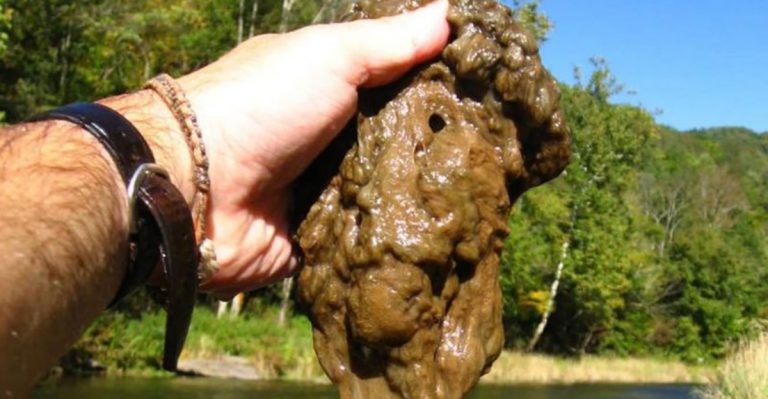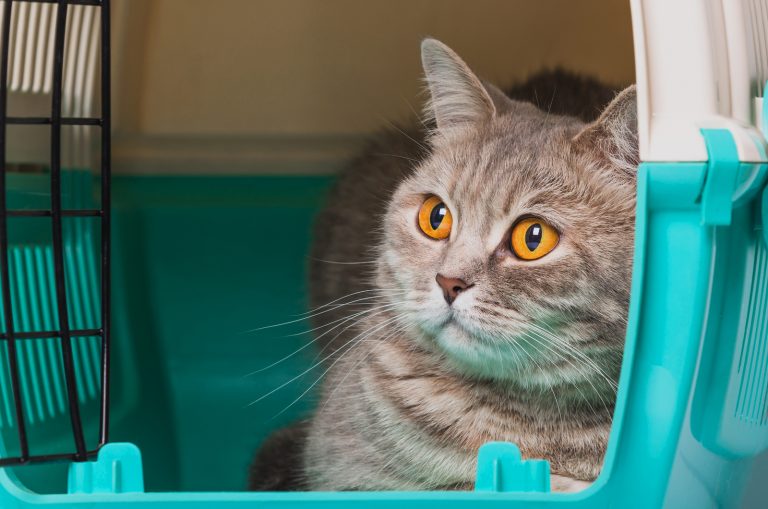7 Pre Labor Signs In Cats: What You Need To Know!
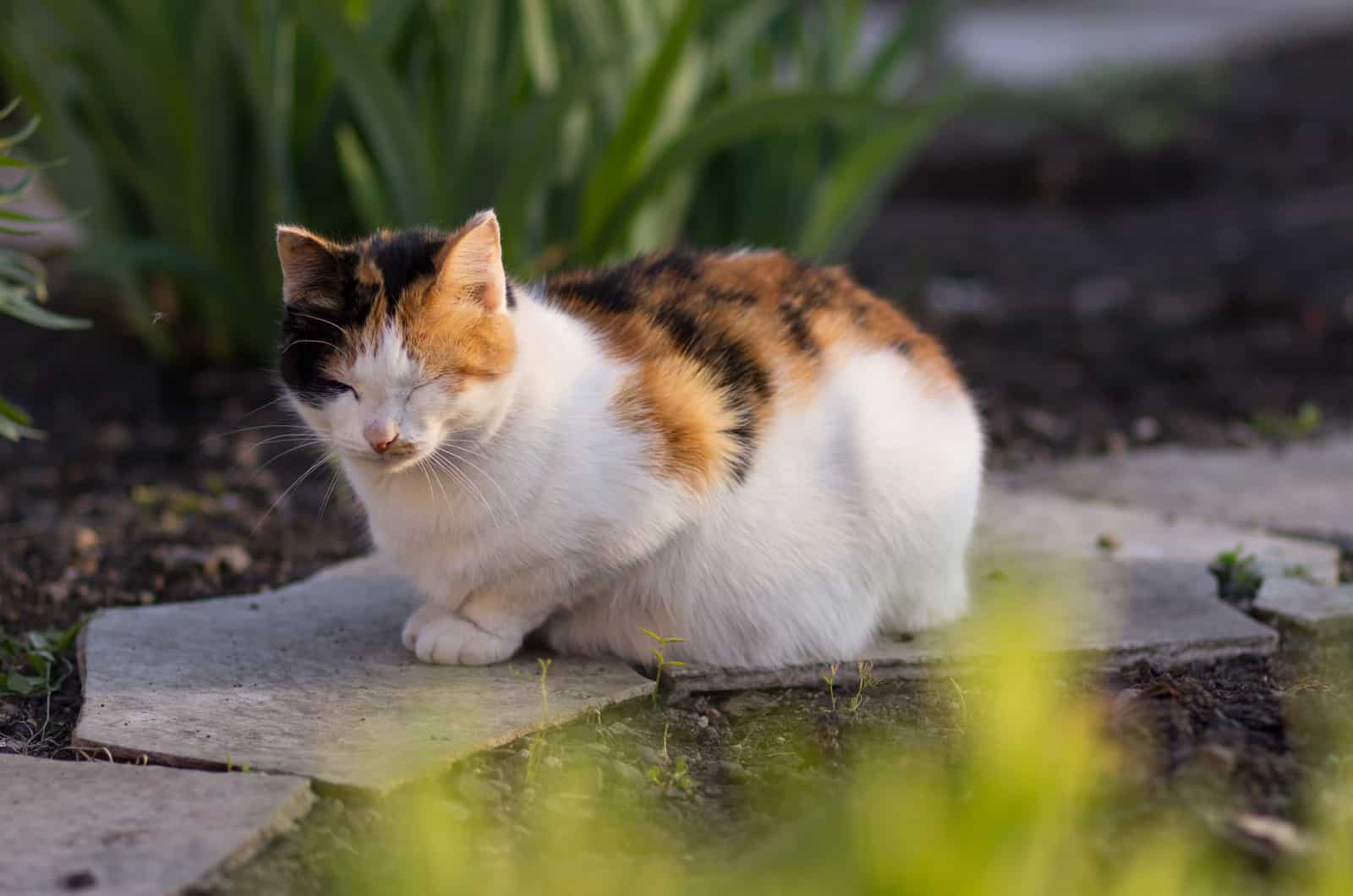
Being a pet parent to a female cat may be a bit more challenging than parenting a male cat. However, when your female cat comes home with a furry surprise, you can’t deny that it’s definitely one of the sweetest things in the world!
So, if your female cat is currently pregnant, you’re in the right place. Every cat owner should know what to do when they have a pregnant cat, especially if it’s her first time.
Read on to learn about cat pregnancy and what you should expect during labor.
By reading this article, you’ll discover the symptoms of pre labor, the different stages of pregnancy, possible complications you should be prepared for, as well as how to take care of your feline and her newborn kittens. So, let’s get started!
7 Pre Labor Signs In Cats
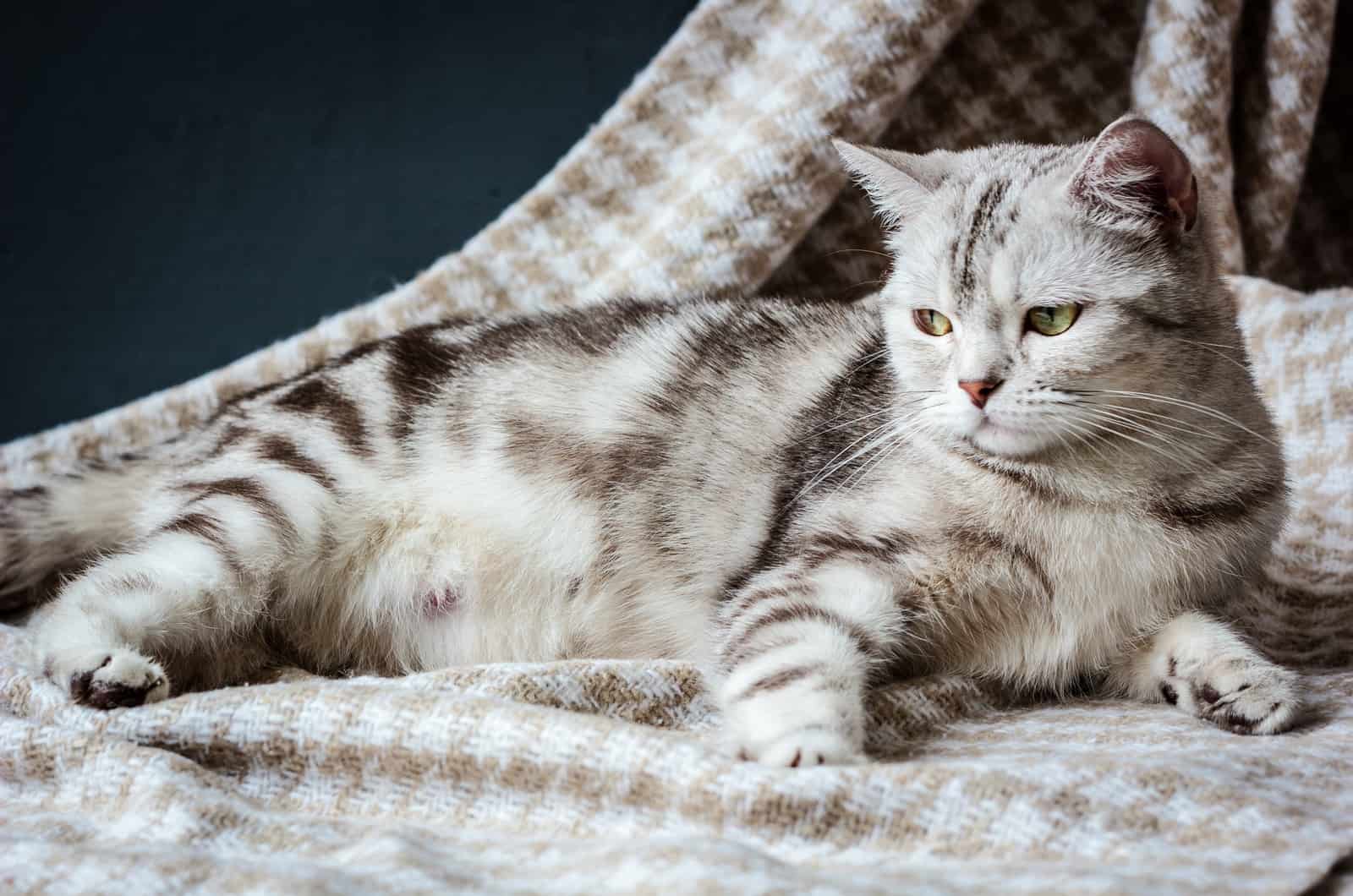
Although a bunch of tiny newborn kittens is one of the sweetest things in the world, a mother cat still requires special care and treatment before and after the birthing process, which can be really challenging.
During this period, cats need a comfortable, calm place to stay and heal, regular vet checks, and, most importantly, a healthy and balanced diet so that they receive enough strength and nutrients for the kittens.
Usually, cats give birth by themselves. However, there can be situations when they require your help or even special attention from the vet. So, it’s very important to monitor your cat as soon as you notice pre labor signs.
If you’re experiencing this for the first time, or you just need some tips, this article may be helpful for both you and your feline friend! So, if you notice any of these symptoms, you’ll be ready!
1. Nesting Behavior
Nesting behavior is common in cats that are about to deliver their kittens. They’re actually looking for the perfect calm and safe spot to nest.
This nesting behavior is a natural instinct in cats, but nature can be very dangerous, especially for newborn kittens.
So, a mother cat is looking for a special place where they’ll be completely safe and warm for the survival of herself and her kittens.
Even indoors, cats look for a perfect spot in the house to nest. You should provide your cat with a nesting box as soon as you notice this behavior. It would not be a bad thing to provide her with a nesting box in advance.
If you cannot get a nesting box, a cardboard box will serve the same function, just make sure you line the bottom with towels or blankets.
Make sure that you place the nesting box in an empty room or a secluded space that is calm and quiet. It’s very important to separate your pregnant feline from other pets and children, if any.
Make sure that she’s comfortable in that environment and that she has everything that she needs.
A nesting box will be ideal for when the kittens are born because they’ll sleep in it. However, after they turn three weeks old, you’ll struggle to stop them from getting out of the box and exploring the space, so ensure you also secure the room where they live!
2. Behavior Changes
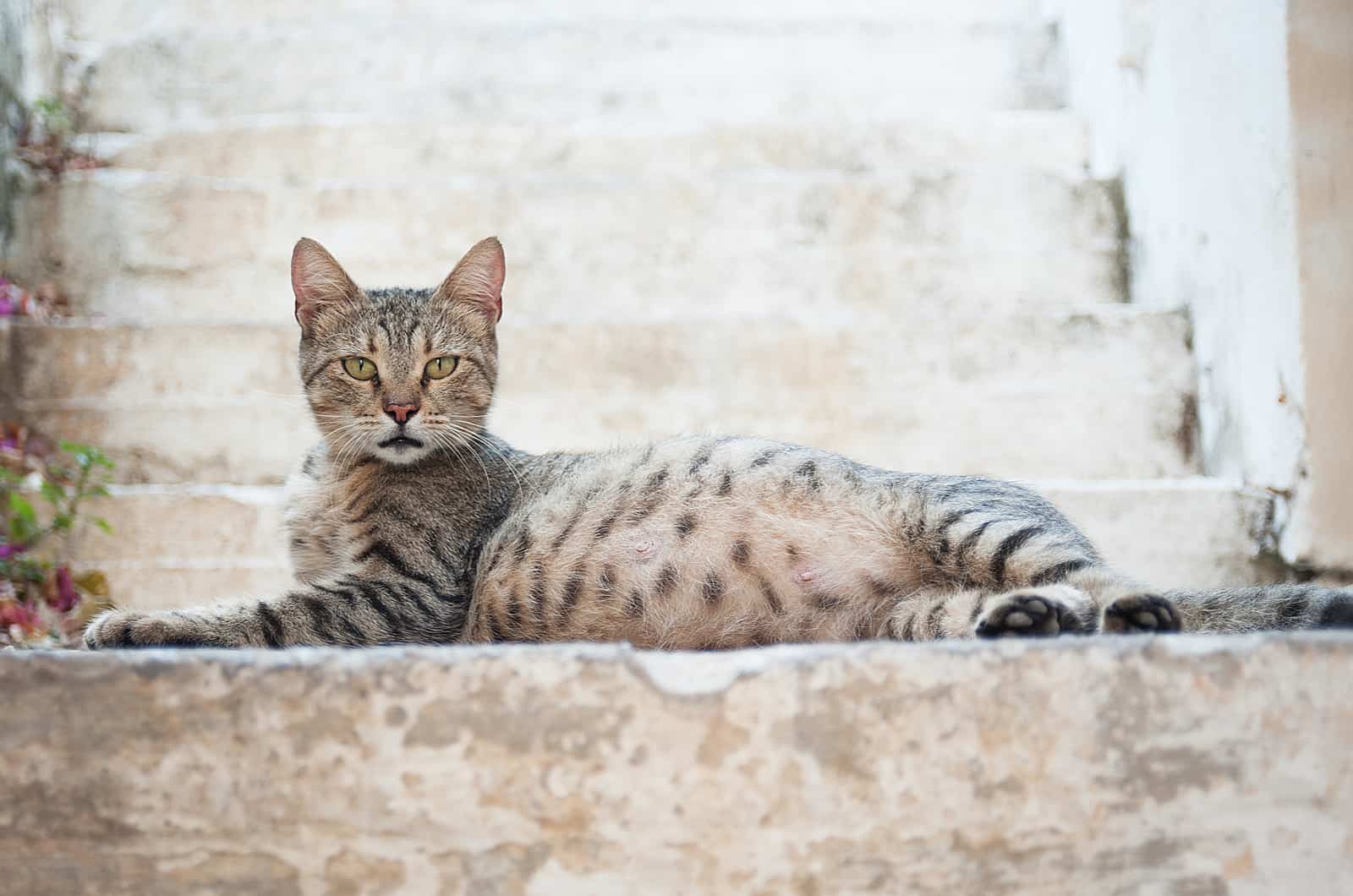
Behavior change is another pre labor sign in cats. They experience thrse changes due to the hormonal changes in their bodies that occur during pregnancy.
Your cat may become more affectionate and clingy towards you before giving birth, which is a sign of having trust in you. By that, your cat friend usually wants to tell you that she needs your help as she’s about to deliver kittens.
However, cats don’t show affection to everyone at that time. They only show it to their owner, who they trust and who usually takes care of them.
Accordingly, it’s no surprise if they become aggressive towards other people. They’re just being overprotective, and it’s completely normal.
That is why it’s also important not to have unknown people around your cat during pre labor or even afterbirth to avoid disturbing your cat. She needs to feel safe and comfortable.
Besides that, they may also feel restless. As the birthing process gets closer, you may notice your cat suffering from sleep disturbances or pacing around more than before.
All in all, behavior changes are a common thing in cat pregnancy. You just need to be prepared for anything and let your feline friend know that you’ll be there for her.
3. Loss Of Appetite
Loss of appetite is one of the clearest signs that your cat’s about to give birth to her furry babies.
When a cat is pregnant, increased appetite is normal because she needs strength for both herself and her babies. She needs energy and strength to give birth properly and keep her kittens healthy.
During that period, it’s very important for your cat to have a healthy and balanced diet. Make sure you’re feeding your cat top-quality food in order to receive all the necessary nutrients for herself and her babies.
However, when the birthing process gets closer, you’ll probably notice a loss of appetite in your feline. At first, that may not seem logical because she still needs enough energy and strength for herself and her kittens.
But, there are two possible reasons for this loss of appetite in pre labor. The first reason is that the kittens are way bigger than before, and they are pushing against the cat’s stomach, causing her to feel full, so she cannot eat.
Another reason is due to hormonal changes. Hormonal changes prepare your feline for the birthing process, and that may make her stressed and anxious; A loss of appetite is also a symptom of anxiety.
Either way, it’s normal, and you shouldn’t worry; however, if you want to be sure, you can always contact your vet and ask for advice.
Your cat should start eating again after giving birth. During the afterbirth, she’ll need a proper diet that contains quality cat food so that she will regain her strength and be able to nurse her kittens properly.
4. Swollen Mammary Glands
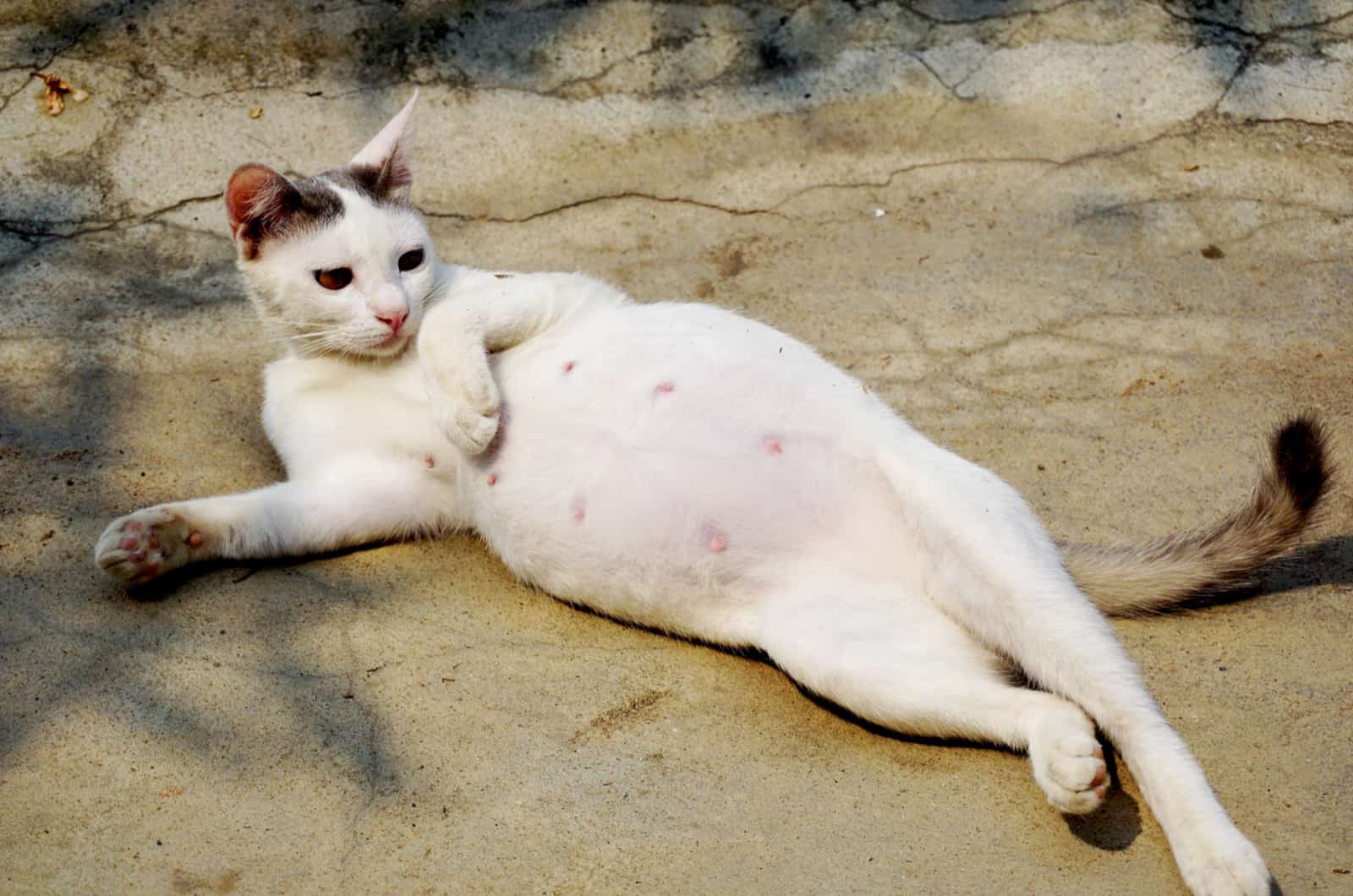
Swollen mammary glands are one of the first and most noticeable pre labor symptoms: the purpose of these mammary glands is to produce milk for the kittens.
The mammary glands are located on the cat’s belly in two parallel rows. Cats usually have four pairs of them; however, that depends on the number of nipples one cat has.
As the birthing process gets closer, the cat’s mammary glands get bigger and bigger because they’re preparing the milk for the litter of kittens.
Kittens will be nursed for around eight weeks of their lives. Some may nurse longer and some shorter. However, it all depends on both the mother cat and her kittens.
Be cautious because a female cat can get pregnant while nursing, so make sure you keep her away from male cats, as it would be exhausting for her to have another litter immediately after the first one.
5. Milk Leakage
Milk leakage is a sign that tells you it’s time for your cat to give birth as mammary glands become swollen when the milk is ready for newborn kittens.
Milk leakage usually appears two days before delivery. You’ll be able to notice a white creamy secretion from the cat’s nipples. Some cats may lick it and some may leave it to slowly leak. All in all, it’s a sign that you should be prepared because the kittens are coming!
6. Excessive Licking And Meowing
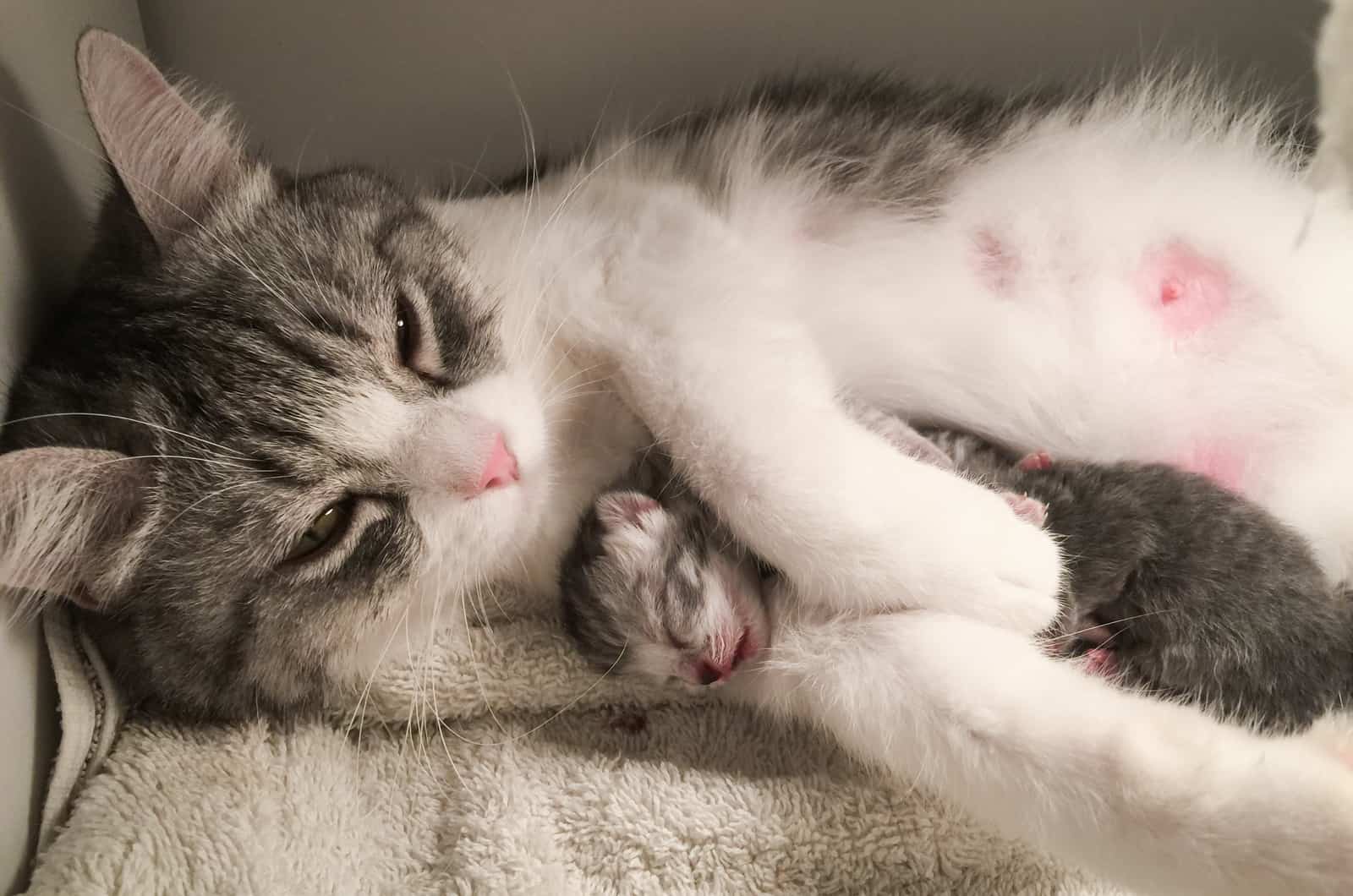
Excessive licking of the belly and genital area and meowing is also one of the pre labor signs in cats. Licking is one of the ways cats deal with pain. When labor gets closer, you may notice your cat excessively licking its belly.
Contractions before labor cause her extreme pain, so she’s trying to reduce it and calm herself by grooming. Moreover, cats also lick vaginal discharge from their genital area during this period. In fact, a cat’s vagina produces a secretion that helps the kittens get out of the uterus more easily.
Knowing that cats are extremely clean animals, it’s not at all weird for your cat to clean herself before labor.
7. Low Body Temperature
Low body temperature usually occurs around two days before labor. However, this sign isn’t as noticeable as others. You would have to measure her temperature all the time to be sure, and it’s much easier to monitor other signs.
However, normal body temperature in cats is between 100.4 and 102.5 ºF. If you notice your cat’s temperature dropping slightly below normal, then that’s it. She is ready to go into labor.
Moreover, as it’s not easy to measure a cat’s body temperature all the time, there are other possible ways you can find out that her body temperature has decreased.
If you notice your feline sleeping in a ball or seeking a warmer place to stay, that is a sign of imminent labor.
Therefore, make sure that your cat’s space is warm and that she has a few spots where she can warm herself up if necessary.
These are the possible pre labor signs in cats. It’s important to monitor your feline throughout the whole pregnancy; however, when you notice one of these signs, it means that you should pay even more attention.
Be there to help your cat during labor, if needed. If you’re not sure what you’re doing, you can always contact your veterinarian and ask them, but I believe that after reading this article, you’ll be able to go through it calmly.
Cat Pregnancy Stages
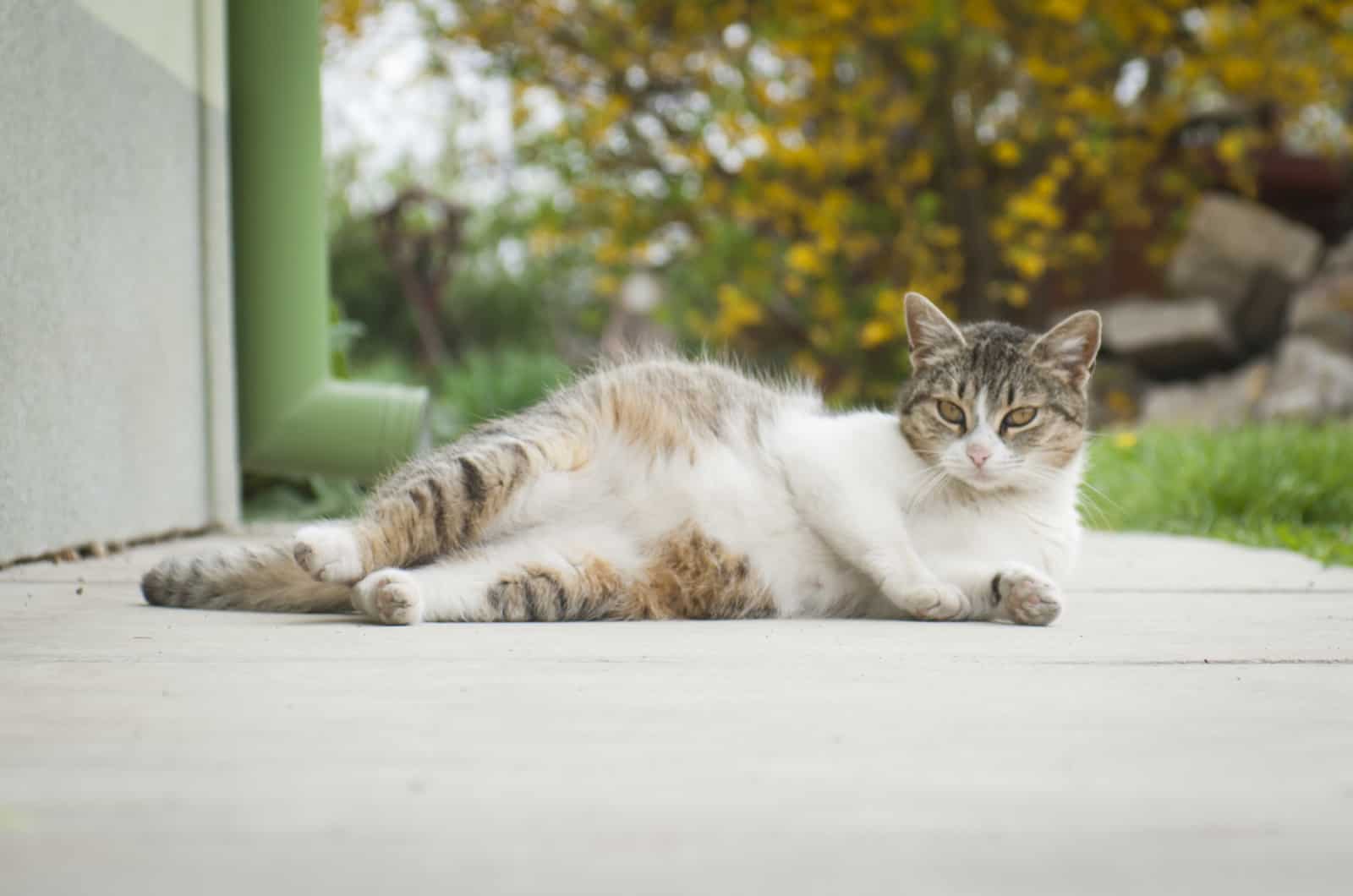
Each cat experiences five different stages of pregnancy. Taking note of each of them may help you recognize them when it’s time for labor.
1. Fertilization
Kittens are already sexually mature at six months of age, and some may take up to 12 months. After this period, female kittens are able to experience heat cycles and, therefore, get pregnant after mating.
Therefore, if you don’t want that, you should spay/neuter your cat, and it’s best to do it at this age.
2. First Stage
This first stage of pregnancy refers to the first four weeks of the cat’s pregnancy or the gestation period. During this period, your cat may show signs of weakness or even morning sickness. Her nipples become slightly swollen and sensitive.
Moreover, you may also feel small lumps on her belly, which are, in fact, kittens developing in her womb. Also, in the third or fourth week of the pregnancy, a veterinarian may detect the fetuses that a cat is carrying via ultrasound, as well as the due date.
3. Second Stage
The second stage of pregnancy refers to the period after the first four weeks. In this period, your cat will have an increased appetite and start gaining weight, and her belly will grow as well.
Moreover, in this second stage, the vet will be able to determine the number of kittens with an x-ray.
4. Pre Labor
Pre labor also consists of three key stages, so let’s check them out!
1. First Stage
In the first stage of labor, a cat’s cervix will start to relax. You won’t notice any contractions; however, other signs of labor will be present in addition to the behavior changes.
During this period, your cat will have a decreased appetite, and her temperature may drop below normal. That’s all normal; however, make sure you monitor her behavior closely as soon as you notice pre labor signs.
2. Second Stage
In this stage of labor, your feline may experience her first contractions. These contractions will eventually become stronger and push the kittens into the pelvis.
The water bag that holds the kittens is also pushed down. It can be noticed on the vulva, and it breaks similar to when a woman’s water breaks.
During this process, the kittens are still in the internal membrane, which helps them leave the womb easily. The mother cat will start pushing, and the first kitten will eventually come out. The same process applies to other kittens.
The duration of the cat’s labor depends on the number of kittens. However, the first kitten should come out within a period of five to 30 minutes. Of course, it all depends on the cat, so it may be shorter or even longer.
3. Third Stage
Finally, in the third stage of labor, a mother cat passes the fetal membranes and placenta. She starts cleaning the kittens and bites through the umbilical cord.
Cats usually eat the placenta, which may seem a bit disgusting; however, the placenta is full of nutrients that help a mother cat recover from labor.
Furthermore, kittens are born with an amniotic sac that the mother cat removes and stimulates the new kitten’s breathing by licking and warming it up.
How To Help Your Cat During Pre Labor
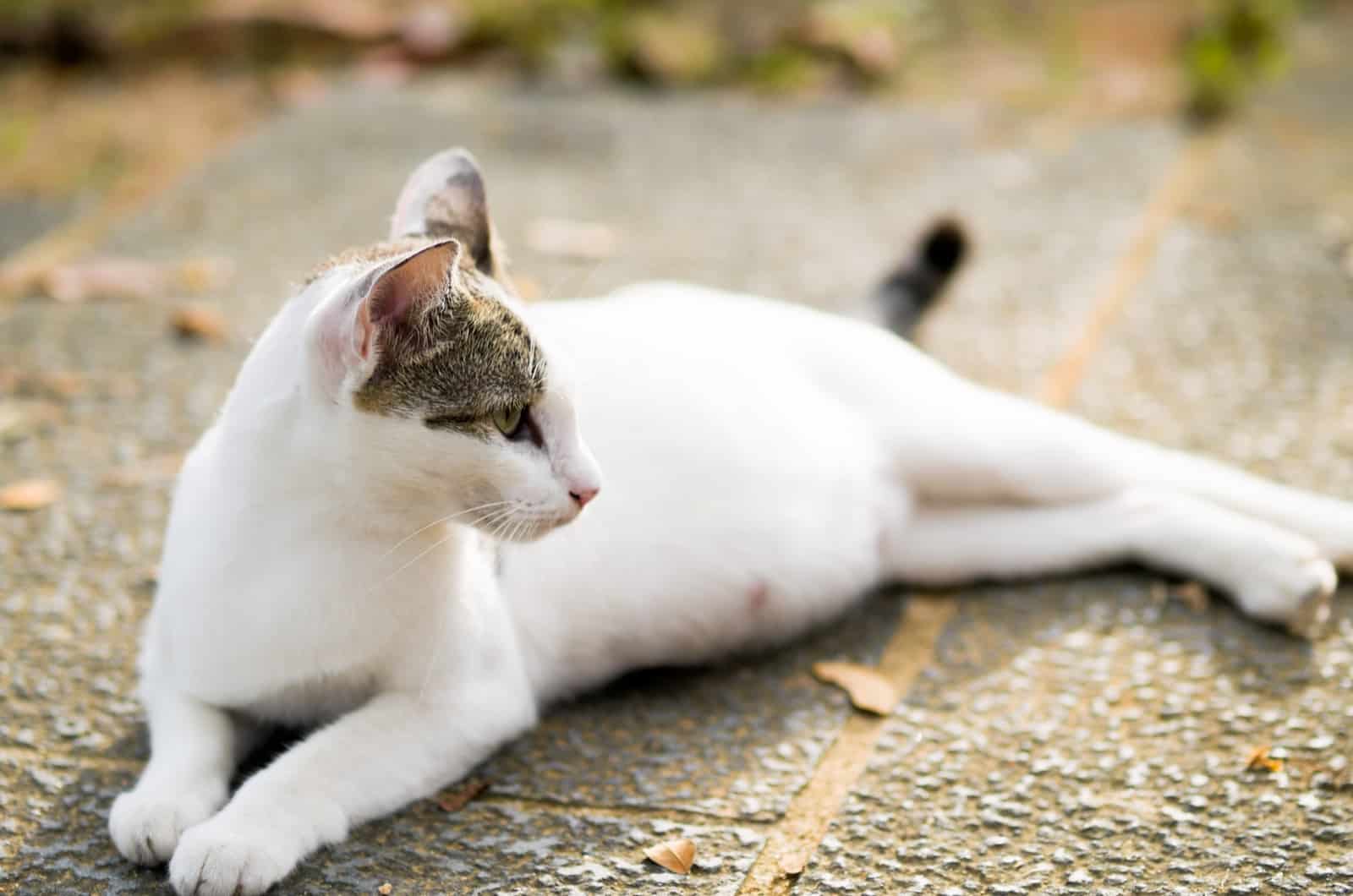
As previously mentioned, cats usually give birth by themselves and don’t need our help. However, it’s totally normal for you to want to help your feline friend somehow, and actually, there are a few things you can do for her!
• Find a perfect place for your cat – make sure that you separate your pregnant kitty from other people, pets, and children. Provide her with a calm and quiet place where she can rest and be comfortable. Moreover, provide her with a nesting box or something similar, a litter box, and make sure she always has fresh water and food.
• Monitor your cat closely – pay attention to your feline and her behavior changes as well as to her needs. She counts on you, so don’t let her down!
• Prepare the necessary things – prepare clean, warm towels in case you need to help your cat with cleaning the kittens. Besides that, make sure you have dental floss and scissors for the umbilical cord, if necessary.
• If necessary, or if you can’t do it by yourself, call your veterinarian to help you!
Possible Complications During Labor
You should always be prepared in case something goes wrong. It doesn’t necessarily mean that bad things will happen, but it’s always good to know or even recognize if something’s wrong.
Read on to find out about the possible complications during labor and what you should do!
1. A Kitten Not Responding
If a kitten is not responding, that’s when you need to react. Try cleaning the membrane from its mouth and nose and tilt its head down for drainage.
Another important thing is to warm up the kitten and stimulate it by gently rubbing it with a towel. For anything further, it would be best to contact your veterinarian and consult with them.
2. Fetal Membrane Retention
It’s highly important that your feline passes the fetal membrane and placenta after birth. If she doesn’t, contact your veterinarian as soon as possible.
If the cat doesn’t pass the fetal membrane. this can lead to serious complications such as infections, fever, brown discharge, loss of appetite, etc.
3. Dystocia
Dystocia is a condition where a cat has a difficult time giving birth due to the size of the kitten or uneasy position.
If you notice your cat becoming lethargic and weak, with zero progress in giving birth, you should contact your veterinarian immediately to get her checked out. It may be that a kitten is stuck in the birth canal and professional veterinary care is required.
Also, if you notice excessive bleeding from the cat’s vulva, make sure you inform your vet about that too.
How To Take Proper Care For Newborn Kittens

Again, a mother cat will take proper care of her kittens, and you usually don’t have to do anything. Just make sure that the mother cat is fine, comfortable, and healthy and that she has everything she needs.
The mother cat will feed and clean her kittens and warm them as much as she can. So, what you should do is provide your cat and her kittens with a lot of towels or blankets to keep them warm at all times, as kittens cannot regulate their temperatures themselves.
Moreover, make sure that the room where they’re located is calm and warm. The kittens are usually ready to be separated from their mother at the age of 12-13 weeks old. Until then, they need to be with their mother for their own good.
FAQ

How Can I Tell If My Cat Is Pregnant?
After 30 days of a cat’s pregnancy, you will notice your cat getting bigger. Moreover, there are certain signs that can help you determine whether your cat is pregnant or not.
You may notice an increased appetite and behavior changes in your cat. Sometimes, she may feel weak and sick. In any case, if you want to be 100% sure, then you should take your cat to the vet, and they’ll be able to determine it by ultrasound or an x-ray.
How Long Does A Cat Stay Pregnant?
A cat’s pregnancy may last for about two months, that is nine weeks. Some may last longer, and some may pass the due date.
How Often Can A Cat Become Pregnant?
Considering that a cat’s pregnancy lasts for about two months, this means that she may have around five litters a year. Soon after giving birth, a cat goes through the heat cycle; therefore, she can get pregnant again. However, it’s not the healthiest thing for a cat!
How Many Kittens Does A Cat Have?
The number of kittens a cat can have depends on the breed. However, the approximate number of kittens a cat can have is four. Some may have more, and some may have less.
How Long Does Pre Labor Last In Cats?
The pre labor in cats lasts 36 hours. It begins with the first stage when the contractions begin and finishes with the birth of the kittens.
Wrapping It Up…
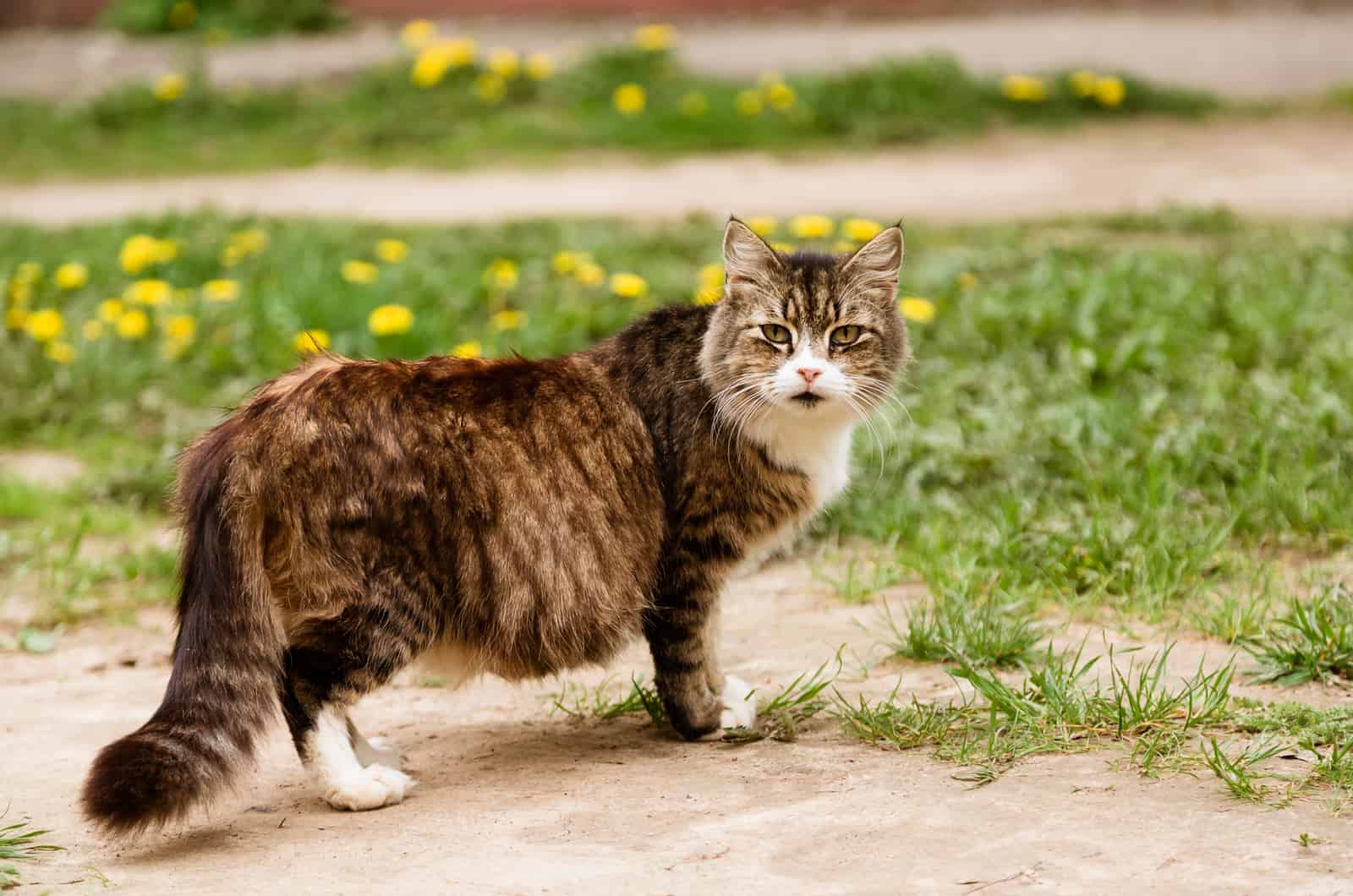
Having read the article, you’ll now know what you should do if your female feline gets pregnant. Cats usually don’t need help when giving birth; however, it’s important to provide her with a perfect spot and monitor her behavior and needs so that you can react if needed.
In short, the main pre labor signs in cats are nesting behavior, behavior changes, swollen mammary glands, milk leakage, low body temperature, excessive licking and meowing, and loss of appetite.
Therefore, if you notice some of these signs, it means that your feline is about to deliver her kittens. Make sure she feels comfortable and safe.
Although rare, you should be prepared, or at least be able to recognize possible complications during labor. In that case, the best thing to do is to contact your veterinarian and ask for help.

